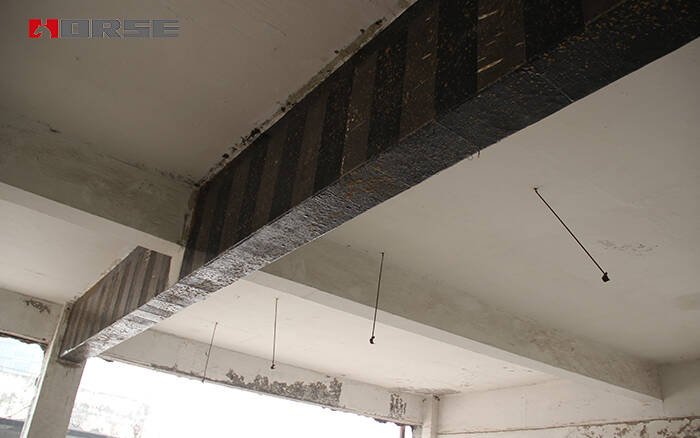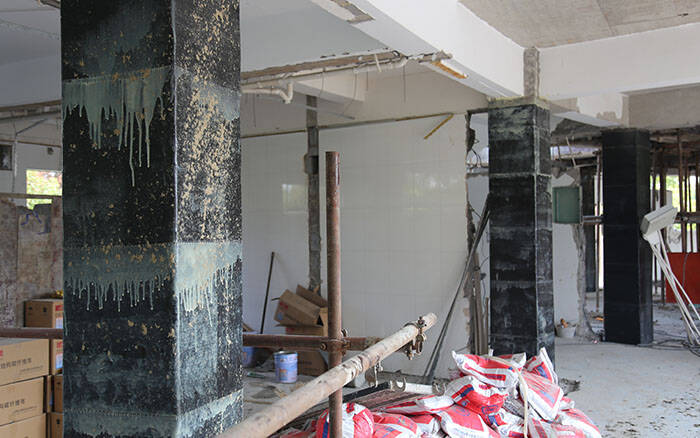Solutions
Horse Construction offers full range of structural strengthening materials with technical supports, documentation supports, products supports, project supports.
Where Can Carbon Fiber Reinforcement Be Used?

The typical failure mode of component bending failure is to produce concentrated cracks that traverse the tension zone to the compression zone. After the carbon fiber sheet is pasted on the surface of the tension zone of the component, it is difficult for the cracks to expand further when the component is loaded. Therefore, the concentrated cracks in the middle of the span are "dispersed" into short and fine cracks and evenly dispersed in the tension zone of the component, which increases the height of the compression zone of the component section. With the reinforcement of carbon fiber, the load-bearing capacity of the flexural member is increased.
The brittle failure of the pier column structure is mainly caused by improper design of the details of the longitudinal reinforcement or insufficient restraint of the lateral stirrups, resulting in the low strength and toughness of the pier column. Adopt the carbon fiber sheet to be pasted on the section where the main reinforcement or the stirrup is insufficient and the carbon fiber sheet is ring-wrapped along the periphery of the column. Due to the high strength and high elastic modulus of the carbon fiber sheet, the lateral deformation of the column can be effectively restrained, the strength and toughness of the pier column can be improved, and its seismic performance can be improved.
The application range of carbon fiber sheet is very wide, mainly in the following aspects.
1) Reinforcement of beam and slab structure
(1) The flexural reinforcement carbon fiber sheet is pasted on the side under tension, that is, the lower part of the mid-span and the upper part of the continuous slab, continuous beam cantilever slab, and beam support along the direction of the reinforcement.
Since the modulus of elasticity of carbon fiber sheets is slightly larger than that of steel bars, and the elongation rate is less than that of steel bars under force, the force is applied first when the structure is stressed. When the load gradually increases to reach the deformation coordination between the two, the two forces are shared and distributed according to a certain proportion. . Often before reinforcement, the cross-sectional area is insufficient due to the corrosion of the original steel bar, or the stress of the original steel bar is too large due to overload. After the reinforcement, the carbon fiber shares the tensile force, which greatly reduces the stress of the steel bar and improves the structural bearing capacity. In the case of bending reinforcement, one or more layers can be pasted according to the force. High elastic modulus sheets can also be used, and the reinforcement effect is more significant.
(2) Shear reinforcement
In the area near the end of the beam where the primary tensile stress is larger, there are secondary beams or larger sets. For the part where the load is affected, the two sides of the beam are vertically pasted with reinforcing sheets, or a U-shaped loop is formed with the bottom of the beam, which is equivalent to adding shear stirrups to share the shear force of the original stirrups.
(3) Anti-fatigue reinforcement
Industrial plant crane beams, bridges and bridge decks can all be pasted with carbon fiber sheets to improve the fatigue resistance of the structure. It is better to paste the bridge deck up and down at the same time.

2) Column and pier reinforcement
(1) Compressive reinforcement of the central compression column, using carbon fiber to wrap around the middle of the column transversely to produce a hoop binding effect in the compression zone, which can improve the compression resistance and reduce the compression yield coefficient of the column.
(2) The eccentric compression column is pasted longitudinally along the column axis on the side of the column under tension and bending, which can be effectively reinforced.
(3) Seismic performance reinforcement. Under the lateral force of ground exhibition or typhoon, the bending moment and shear force of the column end are very large, and the longitudinal bonding and ring wrapping can be carried out at the same time. It not only improves the lateral resistance of columns and piers, but also improves the energy absorption performance, increases the ductility of the structure, and significantly improves the ability of the structure to resist lateral forces.
For building frame structures and bridge pier columns and elevated columns rigidly connected to cap beams, the upper and lower ends of the columns can be reinforced at the same time. For those with weaker upper end lateral restraints, only the lower end can be considered for reinforcement.
3) Enclosure and protection
Sticking with carbon fiber sheets can seal the structural cracks. Wider and deeper cracks can also be sealed with epoxy resin before patching, so as to control the further expansion of the cracks and prevent the penetration of moisture from causing corrosion of the steel bars. At the same time, it also has the effect of enhancing corrosion resistance. This is the side effect of closure and protection while the structure is reinforced. On the contrary, some structures that have been damaged but whose bearing capacity has not been reduced can also be closed and protected and repaired as the main effect, and there are also side effects of structural reinforcement.
In addition, carbon fiber reinforcement is also applied to reinforced concrete structures such as special structures, high-rise structures, tanks, culverts, and tunnels.
At present, carbon fiber reinforcement is mainly applied to the beam-slab structural reinforcement of bridges and general buildings, followed by the seismic reinforcement of bridge pier columns, and other structural reinforcements account for only a small part.
You can find anything here you are in need of, have a trust trying on these products, you will find the big difference after that.

High strength, unidirectional carbon fiber wrap pre-saturated to form a carbon fiber reinforced polymer (CFRP) wrap used to strengthen structural concrete elements.

High strength, unidirectional carbon fiber fabric pre-saturated to form a carbon fiber reinforced polymer (CFRP) fabric used to strengthen structural concrete elements.

High strength, unidirectional carbon fiber sheet pre-saturated to form a carbon fiber reinforced polymer (CFRP) sheet used to strengthen structural concrete elements.